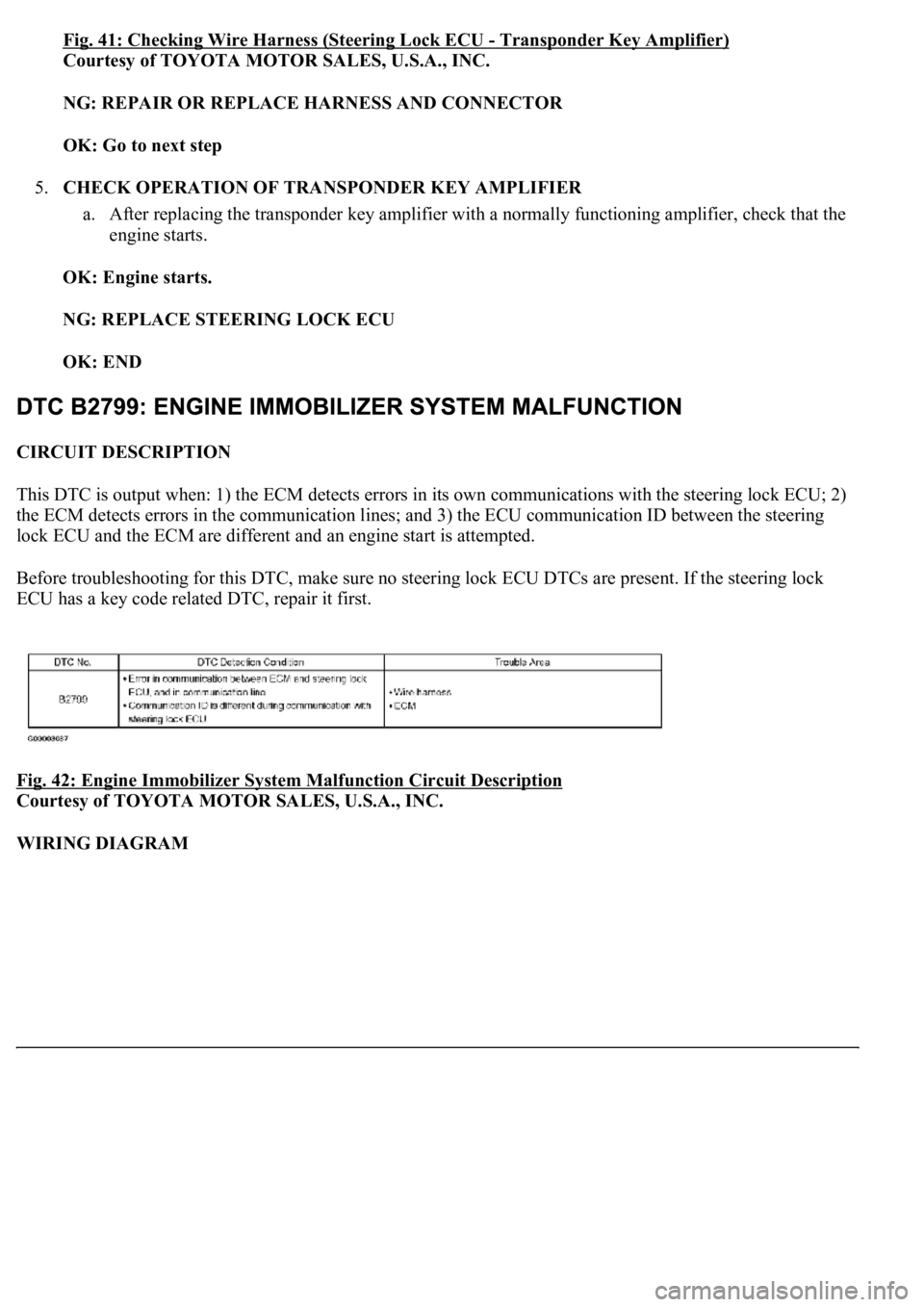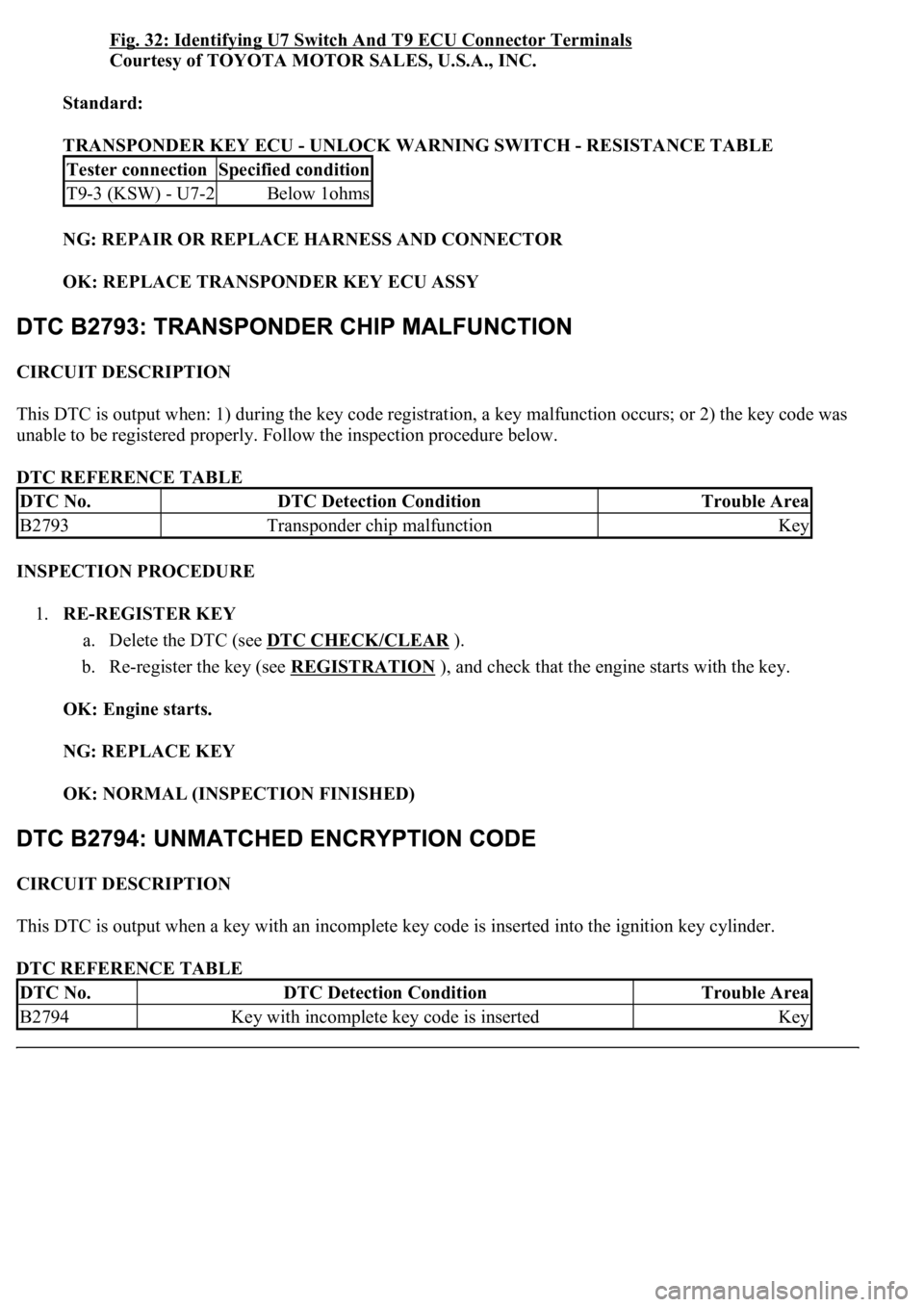Page 3218 of 4500

Fig. 41: Checking Wire Harness (Steering Lock ECU -Transponder Key Amplifier)
Courtesy of TOYOTA MOTOR SALES, U.S.A., INC.
NG: REPAIR OR REPLACE HARNESS AND CONNECTOR
OK: Go to next step
5.CHECK OPERATION OF TRANSPONDER KEY AMPLIFIER
a. After replacing the transponder key amplifier with a normally functioning amplifier, check that the
engine starts.
OK: Engine starts.
NG: REPLACE STEERING LOCK ECU
OK: END
CIRCUIT DESCRIPTION
This DTC is output when: 1) the ECM detects errors in its own communications with the steering lock ECU; 2)
the ECM detects errors in the communication lines; and 3) the ECU communication ID between the steering
lock ECU and the ECM are different and an engine start is attempted.
Before troubleshooting for this DTC, make sure no steering lock ECU DTCs are present. If the steering lock
ECU has a key code related DTC, repair it first.
Fig. 42: Engine Immobilizer System Malfunction Circuit Description
Courtesy of TOYOTA MOTOR SALES, U.S.A., INC.
WIRING DIAGRAM
Page 3219 of 4500
Fig. 43: Engine Immobilizer System Malfunction - Wiring Diagram
Courtesy of TOYOTA MOTOR SALES, U.S.A., INC.
INSPECTION PROCEDURE
1.CHECK WIRE HARNESS (STEERING LOCK ECU - ECM)
a. Disconnect the S46 ECU connector.
b. Disconnect the E2 ECM connector
c. Measure the resistance of the wire harness side connectors.
Standard:
STEERING LOCK ECU - ECM - RESISTANCE TABLE
Tester connectionSpecified condition
S46-13 (EFIO) - E2-6 (IMI)Below 1 ohms
S46-4 (EFII) - E2-7 (IMO)Below 1 ohms
S46-13 (EFIO) or E2-6 (IMI) - Body ground10 kohms or higher
S46-4 (EFII) or E2-7 (IMO) - Body ground10 kohms or higher
Page 3227 of 4500

receives the faint electric wave. Upon receiving the faint electric wave, the transponder chip outputs a key
ID code signal. The transponder key coil receives this signal, the transponder key amplifier amplifies it,
and then the signal is transmitted to the ECU.
The ECU matches the key's ID code with the vehicle's ID code, which was previously registered in the
ECU, and then communicates the results to the ECM using SFI communication.
After the identification results show that the key's ID code matches the vehicle's ID code and the ECU has
confirmed their match: 1) the immobilizer system does not immobilize the engine and the engine starting
controls (fuel injection control and ignition control) enter standby mode; and 2) the ECU transmits a
security indicator signal that communicates "indicator off" to the theft warning ECU (theft deterrent
ECU). Then, the theft warning ECU turns off the security indicator lamp.
HINT:
<00380056004800030057004b004c00560003005300550052004600480047005800550048000300570052000300570055005200580045004f00480056004b00520052005700030057004b0048000300480051004a004c005100480003004c00500050005200
45004c004f004c005d0048005500030056005c005600570048[m. The hand-held tester should be used in steps
4, 5 and 7.
1.VEHICLE BROUGHT TO WORKSHOP
2.CUSTOMER PROBLEM ANALYSIS CHECK AND SYMPTOM CHECK (See CUSTOMER
PROBLEM ANALYSIS CHECK )
3.CRANK ENGINE FOR MORE THAN 10 SECONDS
4.CHECK FOR DTCS
a. Check for DTCs and note any codes that are output.
b. Delete the DTC.
c. Recheck for DTCs. Based on the DTC output in (a), try to force output of the same SFI system
DTC or engine immobilizer system DTC by simulating the operation indicated by the DTC.
1. If the DTC does not reoccur, proceed to A.
2. If the SFI system DTC reoccurs, proceed to B.
3. If the engine immobilizer system DTC reoccurs, proceed to C.
B: Go to SFI SYSTEM (See DIAGNOSTIC TROUBLE CODE CHART
)
C: Go to step 8
A: Go to next step
5.READ DATA LIST USING HAND-HELD TESTER
a. Connect the hand-held tester to the Controller Area Network Vehicle Interface Module (CAN
VIM). Then connect the CAN VIM to the DLC3.
b. Turn the ignition switch ON and push the hand-held tester main switch ON.
c. Read the DATA LIST.
Page 3237 of 4500
a. Register the ECU Communication ID
1. Using SST, connect terminals TC and CG of the DLC3. SST 09843-18040
Fig. 9: Connecting Terminals TC And CG Of DLC3 Using SST
Courtesy of TOYOTA MOTOR SALES, U.S.A., INC.
2. Turn the ignition switch ON (do not start the engine) and leave it as is for 30 minutes.
3. Turn the ignition switch OFF and disconnect terminals TC and CG.
4. Check that the engine starts.
PROBLEM SYMPTOMS TABLE
1.CHECK TRANSPONDER KEY AMPLIFIER
Problem SymptomSuspected AreaProceed To
Engine does not startECU power source circuit
Transponder key ECU assyECU POWER SOURCE CIRCUIT
Page 3262 of 4500

Fig. 32: Identifying U7 Switch And T9 ECU Connector Terminals
Courtesy of TOYOTA MOTOR SALES, U.S.A., INC.
Standard:
TRANSPONDER KEY ECU - UNLOCK WARNING SWITCH - RESISTANCE TABLE
NG: REPAIR OR REPLACE HARNESS AND CONNECTOR
OK: REPLACE TRANSPONDER KEY ECU ASSY
CIRCUIT DESCRIPTION
This DTC is output when: 1) during the key code registration, a key malfunction occurs; or 2) the key code was
unable to be registered properly. Follow the inspection procedure below.
DTC REFERENCE TABLE
INSPECTION PROCEDURE
1.RE-REGISTER KEY
a. Delete the DTC (see DTC CHECK/CLEAR
).
b. Re-register the key (see REGISTRATION
), and check that the engine starts with the key.
OK: Engine starts.
NG: REPLACE KEY
OK: NORMAL (INSPECTION FINISHED)
CIRCUIT DESCRIPTION
This DTC is output when a key with an incomplete key code is inserted into the ignition key cylinder.
DTC REFERENCE TABLE
Tester connectionSpecified condition
T9-3 (KSW) - U7-2Below 1ohms
DTC No.DTC Detection ConditionTrouble Area
B2793Transponder chip malfunctionKey
DTC No.DTC Detection ConditionTrouble Area
B2794Key with incomplete key code is insertedKey
Page 3263 of 4500
INSPECTION PROCEDURE
REPLACE KEY
CIRCUIT DESCRIPTION
This DTC is output when a key with a key code that has not been registered in the ECU is inserted into the
ignition key cylinder.
DTC REFERENCE TABLE
INSPECTION PROCEDURE
1.DELETE DTC AND INSERT ALL PRESENTLY AVAILABLE KEYS TO CHECK WHETHER
ENGINE STARTS OR NOT
OK: Engine starts.
NG: REPLACE KEY THAT CANNOT START ENGINE
OK: NO PROBLEM (BECAUSE OF KEY RE-REGISTRATION)
CIRCUIT DESCRIPTION
This DTC is output when a key that does not have a transponder chip is inserted into the ignition key cylinder or
if communication between the key and transponder key ECU is not possible.
Fig. 33: DTC Reference Chart
Courtesy of TOYOTA MOTOR SALES, U.S.A., INC.
WIRING DIAGRAM
DTC No.DTC Detection ConditionTrouble Area
B2795Key with unregistered key code is insertedKey
Page 3264 of 4500
Fig. 34: DTCs B2796, B2798 - Wiring Diagram
Courtesy of TOYOTA MOTOR SALES, U.S.A., INC.
INSPECTION PROCEDURE
1.READ DATA LIST USING HAND-HELD TESTER
a. Connect the hand-held tester to the CAN VIM. Then connect the CAN VIM to the DLC3.
b. Turn the ignition switch ON with the key that cannot start the engine.
c. Read the DATA LIST.
Transponder key ECU assy:
Fig. 35: Transponder Key ECU Assy Data List
Courtesy of TOYOTA MOTOR SALES, U.S.A., INC.
OK: "UNSET" (Ignition switch ON) appears on the screen.
NG: Go to step 2
OK: REPLACE TRANSPONDER KEY ECU ASSY
2.CHECK WHETHER ENGINE STARTS WITH OTHER KEYS
Page 3265 of 4500
a. Check if the engine starts with the vehicle's other keys.
OK: Engine starts.
NG: Go to step 3
OK: RE-REGISTER OR REPLACE KEY THAT CANNOT START ENGINE
3.CHECK WIRE HARNESS (TRANSPONDER KEY ECU ASSY - TRANSPONDER KEY
AMPLIFIER)
a. Disconnect the T9 ECU connector.
b. Disconnect the T8 amplifier connector.
c. Measure the resistance of the wire harness side connectors.